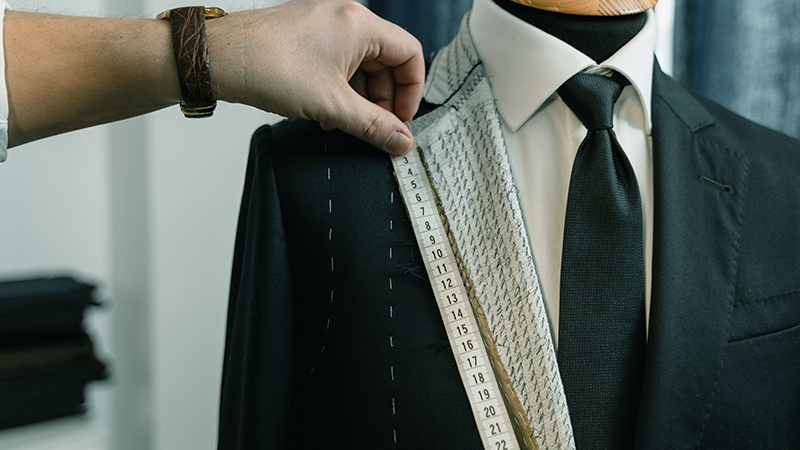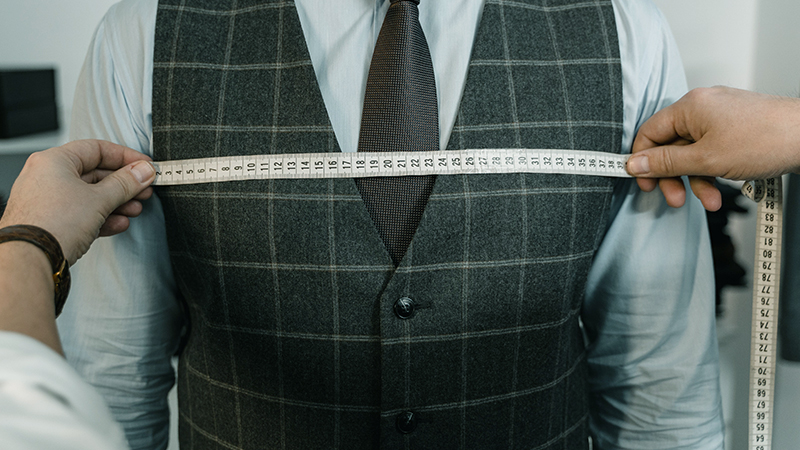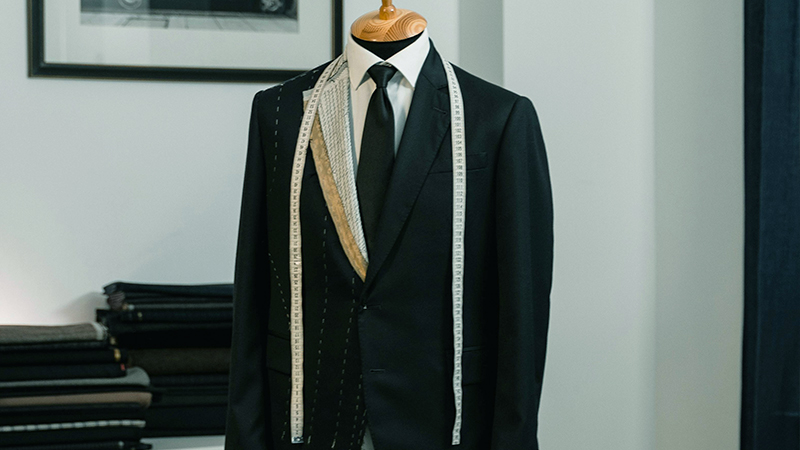The process of tailoring a suit is an intricate blend of artistry and precision, capturing the essence of personalized fashion. For many, the journey of crafting a bespoke suit is as important as the final garment itself.
One burning question that resonates with anyone seeking sartorial elegance is, “How long does it take to tailor a suit?” This query delves into the heart of the meticulous craftsmanship involved, exploring the stages that transform fabric into a tailored masterpiece.
From initial consultations to final fittings, every step demands time and expertise. Understanding the timeline is not just a matter of convenience; it’s an insight into the dedication and expertise required in the world of bespoke tailoring.
Let’s unravel the layers of this creative process and discover the intricate tapestry of time and skill that results in a perfectly tailored suit.

How Long Does It Take To Tailor A Suit?
The time it takes to tailor a suit can vary based on several factors, including the complexity of the design, the tailor’s workload, and the alterations needed.
Here’s a breakdown of the different stages involved in tailoring a suit and the approximate time it might take for each step:
Consultation and Measurements (1-2 hours)
The initial meeting with the tailor involves discussing your preferences, choosing fabrics, and taking detailed measurements.
This step is crucial for ensuring a well-fitted suit and can take anywhere from 1 to 2 hours, depending on the discussion and measurements needed.
Pattern Making (1-2 days)
After the consultation, the tailor creates a pattern based on your measurements. This step can take a day or two, as it requires precision and attention to detail to ensure the pattern fits your body shape perfectly.
Cutting the fabric (1 day)
Once the pattern is ready, the tailor cuts the chosen fabric according to the pattern. This step usually takes a day, as it involves careful cutting to avoid any mistakes and waste of material.
Assembly and Stitching (1-2 weeks)
The actual assembly and stitching of the suit pieces take the most time. Skilled tailors work meticulously to sew the suit together, ensuring the seams are even and the fit is impeccable.
This process can take anywhere from 1 to 2 weeks, depending on the tailor’s workload and the complexity of the design.
Fittings and Adjustments (1-2 days)
After the initial assembly, you’ll have one or more fitting sessions to check the suit’s fit. The tailor will make any necessary adjustments during these sessions, which can take another day or two, depending on the changes required.
Final Stitching and Finishing (1-2 days)
Once the final adjustments are made, the suit goes through the last round of stitching and finishing touches. This includes adding buttons, buttonholes, and hemming the trousers. This step can take another day or two to complete.
Pressing and Quality Check (1 day)
The final step involves pressing the suit to remove any wrinkles and ensure a polished look. The tailor also conducts a thorough quality check to make sure every detail is perfect before the suit is ready for pickup. This step usually takes a day.
Keep in mind that these timeframes are approximate and can vary based on the tailor’s expertise, workload, and the specific requirements of the suit. It’s essential to discuss the timeline with your tailor beforehand, especially if you have a specific deadline in mind.
What Is The Idle Time To Finish Tailoring A Suit?

The idle time to finish tailoring a suit refers to periods when the suit is not actively being worked on due to various reasons. These idle times can vary depending on the tailor’s workflow, the complexity of the project, and external factors.
Here are some common idle times in the process of tailoring a suit:
Pattern Creation Waiting (1-2 days)
After the initial measurements, the tailor may need some time to create the pattern for the suit. This idle time allows for precision and ensures that the pattern is perfectly tailored to your measurements.
It can take 1-2 days, depending on the tailor’s schedule and workload.
Fabric Sourcing Delays (Variable)
Sometimes, obtaining the chosen fabric can lead to delays, especially if it needs to be ordered or is in high demand. The idle time here can be highly variable, but it might range from a few days to several weeks.
Stitching and Assembly Queues (Variable)
Tailors may have multiple projects in their queue, and your suit will need to wait its turn for stitching and assembly. The idle time can vary based on the tailor’s workload and the number of suits in line ahead of yours. It might range from a few days to a few weeks.
Fittings and Customer Availability (Variable)
Fitting sessions depend on the customer’s availability. If the customer is not readily available for fittings, it can result in idle time as the tailor waits for feedback and adjustments. The duration varies depending on the customer’s schedule.
Supply Chain Delays (Variable)
If the tailor relies on specific suppliers for materials, delays in the supply chain, such as delays in receiving buttons or linings, can cause idle time. The duration is highly variable and dependent on external factors.
Specialty Techniques or Custom Features (Variable)
If your suit includes unique or intricate details that require special techniques or additional time, there may be idle periods. These depend on the complexity of the requested features and the tailor’s skill in executing them.
Quality Check and Final Inspection (1 day)
Before the suit is deemed complete, there is an idle period while it undergoes a final quality check. This is a crucial step to ensure the suit meets the highest standards, and it usually takes a day.
It’s essential to communicate with your tailor about expected idle times and any specific deadlines you may have. This will help both you and the tailor manage expectations and ensure a smooth tailoring process.
Tailoring a suit is a meticulous craft that often involves waiting for the best results, so patience is key.
How Quickly Can A Suit Be Tailored?

The speed at which a suit can be tailored depends on several factors, including the tailor’s expertise, the complexity of the design, and the availability of materials.
Here’s a breakdown of the different stages involved in tailoring a suit and the approximate time it might take for each step when the process is expedited:
Rapid Consultation and Measurements (1 hour)
A quick consultation and measurement session can be completed within an hour. During this time, the tailor assesses your preferences, takes essential measurements, and discusses fabric choices.
Fast-Track Pattern Making (1 day)
Skilled tailors can expedite the pattern-making process, creating a precise pattern in a single day, ensuring it fits your body shape perfectly.
Efficient Fabric Cutting (1 day)
Cutting the fabric quickly yet accurately is crucial. With experienced hands, the tailor can complete this step within a day, minimizing the wastage of material.
Swift Assembly and Stitching (3-5 days)
A focused and experienced team of tailors can assemble and stitch the suit pieces together in 3 to 5 days. Teamwork and efficient allocation of tasks significantly reduces the time required for this step.
Prompt Fittings and Adjustments (1-2 days)
Fitting sessions are scheduled promptly, allowing for immediate adjustments. Skilled tailors can make necessary alterations within 1 to 2 days, ensuring a proper fit.
Speedy Final Stitching and Finishing (1-2 days)
The final stitching, including adding buttons and buttonholes, is completed swiftly. Finishing touches are applied promptly, taking 1 to 2 days to give the suit a polished look.
Quick Pressing and Quality Check (1 day)
The last step involves pressing the suit to remove wrinkles and conducting a rapid quality check. Experienced professionals can complete this step within a day, ensuring the suit is ready for pickup.
It’s important to note that this expedited timeline assumes that all materials are readily available and that the tailor has a dedicated team working on the suit.
Additionally, an expedited service may come at an additional cost due to the prioritization of your order and the need for a quicker turnaround. Communication with the tailor is key to ensuring your expectations align with the accelerated timeline.
How To Find A Suit Tailor Near Me?

Finding a suit tailor near you can be essential for achieving a perfectly fitted and customized suit. Here are the tips to help you locate a reputable tailor in your vicinity:
Ask for Recommendations
Begin by asking friends, family, or colleagues for recommendations. Word-of-mouth referrals are often the most reliable way to find a reputable tailor. Personal experiences can give you insight into the tailor’s skill and customer service.
Online Reviews and Ratings
Use online resources like Google, Yelp, or dedicated review websites to read customer reviews and ratings for local tailors. Pay attention to both positive and negative feedback to get a sense of the tailor’s reputation.
Local Business Directories
Check local business directories, both online and in print, for listings of tailors in your area. These directories often provide contact information, location, and a brief description of services.
Visit Clothing Stores
High-end clothing stores or menswear shops often have in-house tailors or can recommend a tailor they work with. They can provide guidance on which tailors have experience in specific styles or alterations.
Online Tailor Directories
There are online directories dedicated to tailors and alterations specialists. Websites like The Tailor Locator or The Tailor Network can help you find tailors in your area.
Social Media and Forums
Search for local tailor recommendations on social media platforms like Facebook groups or fashion forums. Many communities have dedicated groups where members share their experiences and offer suggestions.
Check Their Portfolio
Once you’ve identified potential tailors, ask to see their portfolio or examples of their work. This allows you to assess their style, attention to detail, and the quality of their tailoring.
When you’ve identified potential suit tailors near you, it’s important to visit or contact them for a consultation. During the consultation, discuss your specific needs and ask about pricing, turnaround times, and any unique services they offer.
This will help you make an informed decision and choose the tailor that best aligns with your preferences and requirements.
FAQs
How long does it take to tailor a custom suit?
The duration for crafting a custom suit depends on several factors, including the tailor’s workload, the complexity of the design, and the number of fittings required. In general, it can take anywhere from 4 to 8 weeks.
Can alterations be done faster than creating a new suit?
Yes, alterations typically require less time compared to creating a new suit. Basic alterations like hemming trousers or adjusting the jacket sleeves can often be done in a few days, while more complex alterations may take a week or two.
What affects the turnaround time for tailoring a suit?
Several factors impact the turnaround time, including the tailor’s skill, workload, fabric availability, and the complexity of the suit design. Effective communication with your tailor can help set reasonable expectations for the timeline.
Can I get a suit tailored in a day for a special event?
While same-day tailoring services may be available for minor alterations, creating an entirely new suit within a day is usually not feasible for quality craftsmanship. It’s advisable to plan well in advance, allowing for several weeks to ensure your suit is tailored to perfection.
Is there a difference in tailoring times for men’s and women’s suits?
The tailoring time for men’s and women’s suits is generally similar. The key factors impacting the timeline are the intricacy of the design and the specific requirements of the customer rather than the gender of the suit.
Conclusion
In the realm of bespoke fashion, the question of how long it takes to tailor a suit reveals the careful orchestration of craftsmanship and dedication.
Each stage, from measurements to final stitching, contributes to the suit’s journey from a mere bolt of fabric to a personalized emblem of style.
As we’ve explored the various phases involved, it becomes evident that the timeline is a testament to the artistry and precision embedded in the world of tailoring.
Beyond the hours and days, it represents a harmonious blend of creativity and technique, ensuring that every stitch aligns with perfection.
So, when you don your tailored suit, remember the patient hands and skilled minds that invested their time, ultimately creating a garment that not only fits flawlessly but also tells a story of craftsmanship that stands the test of time.
Leave a Reply